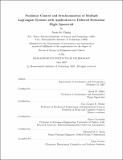| dc.contributor.advisor | David W. Miller and Jean-Jacques E. Slotine. | en_US |
| dc.contributor.author | Chung, Soon-Jo, 1976- | en_US |
| dc.contributor.other | Massachusetts Institute of Technology. Dept. of Aeronautics and Astronautics. | en_US |
| dc.date.accessioned | 2008-02-27T20:36:47Z | |
| dc.date.available | 2008-02-27T20:36:47Z | |
| dc.date.copyright | 2007 | en_US |
| dc.date.issued | 2007 | en_US |
| dc.identifier.uri | http://ssl.mit.edu/spheres/videos.html | en_US |
| dc.identifier.uri | http://hdl.handle.net/1721.1/40304 | |
| dc.description | Thesis (Sc. D.)--Massachusetts Institute of Technology, Dept. of Aeronautics and Astronautics, 2007. | en_US |
| dc.description | This electronic version was submitted by the student author. The certified thesis is available in the Institute Archives and Special Collections. | en_US |
| dc.description | Includes bibliographical references (p. 217-228). | en_US |
| dc.description.abstract | This dissertation focuses on the synchronization of multiple dynamical systems using contraction theory, with applications to cooperative control of multi-agent systems and synchronization of interconnected dynamics such as tethered formation flight. Inspired by stable combinations of biological systems, contraction nonlinear stability theory provides a systematic method to reduce arbitrarily complex systems into simpler elements. One application of oscillation synchronization is a fully decentralized nonlinear control law, which eliminates the need for any inter-satellite communications. We use contraction theory to prove that a nonlinear control law stabilizing a single-tethered spacecraft can also stabilize arbitrarily large circular arrays of tethered spacecraft, as well as a three-spacecraft inline configuration. The convergence result is global and exponential due to the nature of contraction analysis. The proposed decentralized control strategy is further extended to robust adaptive control in order to account for model uncertainties. Numerical simulations and experimental results validate the exponential stability of the tethered formation arrays by implementing a tracking control law derived from the reduced dynamics. | en_US |
| dc.description.abstract | (cont.) This thesis also presents a new synchronization framework that can be directly applied to cooperative control of autonomous aerospace vehicles and oscillation synchronization in robotic manipulation and locomotion. We construct a dynamical network of multiple Lagrangian systems by adding diffusive couplings to otherwise freely moving or flying vehicles. The proposed tracking control law synchronizes an arbitrary number of robots into a common trajectory with global exponential convergence. The proposed control law is much simpler than earlier work in terms of both the computational load and the required signals. Furthermore, in contrast with earlier work which used simple double integrator models, the proposed method permits highly nonlinear systems and is further extended to adaptive synchronization, partial-joint coupling, and concurrent synchronization. Another contribution of the dissertation is a novel nonlinear control approach for underactuated tethered formation flight spacecraft. This is motivated by a controllability analysis that indicates that both array resizing and spin-up are fully controllable by the reaction wheels and the tether motor. This work reports the first propellant-free underactuated control results for tethered formation flight. | en_US |
| dc.description.abstract | (cont.) We also fulfill the potential of the proposed strategy by providing a new momentum dumping method. This dissertation work has evolved based on the research philosophy of balancing theoretical work with practicality, aiming at physically intuitive algorithms that can be directly implemented in real systems. In order to validate the effectiveness of the decentralized control and estimation framework, a new suite of hardware has been designed and added to the SPHERES (Synchronize Position Hold Engage and Reorient Experimental Satellite) testbed. Such recent improvements described in this dissertation include a new tether reel mechanism, a force-torque sensor and an air-bearing carriage with a reaction wheel. This thesis also introduces a novel relative attitude estimator, in which a series of Kalman filters incorporate the gyro, force-torque sensor and ultrasound ranging measurements. The closed-loop control experiments can be viewed at ... | en_US |
| dc.description.statementofresponsibility | by Soon-Jo Chung. | en_US |
| dc.format.extent | 228 p. | en_US |
| dc.language.iso | eng | en_US |
| dc.publisher | Massachusetts Institute of Technology | en_US |
| dc.rights | M.I.T. theses are protected by copyright. They may be viewed from this source for any purpose, but reproduction or distribution in any format is prohibited without written permission. See provided URL for inquiries about permission. | en_US |
| dc.rights.uri | http://ssl.mit.edu/spheres/videos.html | en_US |
| dc.rights.uri | http://dspace.mit.edu/handle/1721.1/7582 | |
| dc.subject | Aeronautics and Astronautics. | en_US |
| dc.title | Nonlinear control and synchronization of multiple Lagrangian systems with application to tethered formation flight spacecraft | en_US |
| dc.type | Thesis | en_US |
| dc.description.degree | Sc.D. | en_US |
| dc.contributor.department | Massachusetts Institute of Technology. Department of Aeronautics and Astronautics | |
| dc.identifier.oclc | 191223485 | en_US |
